
Technical Analysis from A to Z
by Steven B. Achelis
MOVING AVERAGES
Moving Averages
Moving averages are one of the oldest and most popular technical analysis tools. This chapter describes the basic calculation and interpretation of moving averages. Full details on moving averages are provided in Part Two.
A moving average is the average price of a security at a given time. When calculating a moving average, you specify the time span to calculate the average price (e.g., 25 days).
A "simple" moving average is calculated by adding the security's prices for the most recent "n" time periods and then dividing by "n." For example, adding the closing prices of a security for most recent 25 days and then dividing by 25. The result is the security's average price over the last 25 days. This calculation is done for each period in the chart.
Note that a moving average cannot be calculated until you have "n" time periods of data. For example, you cannot display a 25-day moving average until the 25th day in a chart.
Figure 23 shows a 25-day simple moving average of the closing price of Caterpillar.
Figure 23
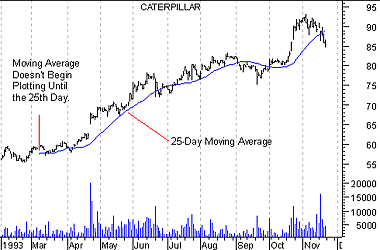
Since the moving average in this chart is the average price of the security over the last 25 days, it represents the consensus of investor expectations over the last 25 days. If the security's price is above its moving average, it means that investor's current expectations (i.e., the current price) are higher than their average expectations over the last 25 days, and that investors are becoming increasingly bullish on the security. Conversely, if today's price is below its moving average, it shows that current expectations are below average expectations over the last 25 days.
The classic interpretation of a moving average is to use it to observe changes in prices. Investors typically buy when a security's price rises above its moving average and sell when the price falls below its moving average.
Time periods in moving averages
"Buy" arrows were drawn on the chart in Figure 24 when Aflac's price rose above its 200-day moving average; "sell" arrows were drawn when Aflac's price fell below its 200-day moving average. (To simplify the chart, I did not label the brief periods where Aflac crossed its moving average for only a few days.)
Figure 24
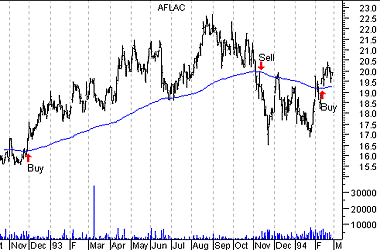
Long-term trends are often isolated using a 200-day moving average. You can also use computer software to automatically determine the optimum number of time periods. Ignoring commissions, higher profits are usually found using shorter moving averages.
Merits
The merit of this type of moving average system (i.e., buying and selling when prices penetrate their moving average) is that you will always be on the "right" side of the market--prices cannot rise very much without the price rising above its average price. The disadvantage is that you will always buy and sell late. If the trend doesn't last for a significant period of time, typically twice the length of the moving average, you'll lose money. This is illustrated in Figure 25.
Figure 25
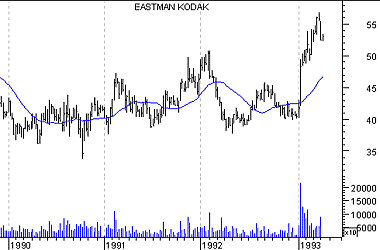
Traders' remorse
Moving averages often demonstrate traders' remorse. As shown in Figure 26, it is very common for a security to penetrate its long-term moving average, and then return to its average before continuing on its way.
Figure 26
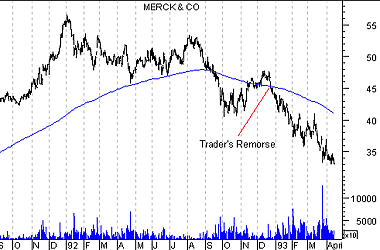
You can also use moving averages to smooth erratic data. The charts in Figure 27 show the 13 year history of the number of stocks making new highs (upper chart) and a 10-week moving average of this value (lower chart). Note how the moving average makes it easier to view the true trend of the data.
Figure 27
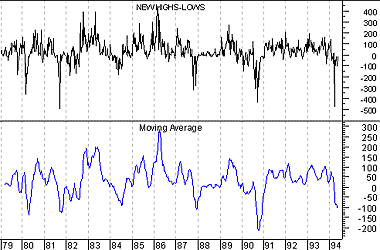
Contents
- Preface
- Acknowledgments
- Terminology
- To Learn More
- Bibliography
- About the Author
- Technical Analysis
- Price Fields
- Charts
- Support & Resistance
- Trends
- Moving Averages
- Indicators
- Market Indicators
- Line Studies
- Periodicity
- The Time Element
- Conclusion
- Absolute Breadth Index
- Accumulation/Distribution
- Accumulation Swing Index
- Advance/Decline Line
- Advance/Decline Ratio
- Advancing-Declining Issues
- Advancing, Declining, Unchanged Volume
- Andrews' Pitchfork
- Arms Index
- Average True Range
- Bollinger Bands
- Breadth Thrust
- Bull/Bear Ratio
- Candlesticks - Japanese
- CANSLIM
- Chaikin Oscillator
- Commodity Channel Index
- Commodity Selection Index
- Correlation Analysis
- Cumulative Volume Index
- Cycles
- Demand Index
- Detrended Price Oscillator
- Directional Movement
- Dow Theory
- Ease of Movement
- Efficient Market Theory
- Elliott Wave Theory
- Envelopes (Trading Bands)
- Equivolume/Candlevolume
- Fibonacci Studies
- Four Percent Model
- Fourier Transform
- Fundamental Analysis
- Gann Angles
- Herrick Payoff Index
- Interest Rates
- Kagi
- Large Block Ratio
- Linear Regression Lines
- MACD
- Mass Index
- McClellan Oscillator
- McClellan Summation Index
- Median Price
- Member Short Ratio
- Momentum
- Money Flow Index
- Moving Averages
- Negative Volume Index
- New Highs-Lows Cumulative
- New Highs-New Lows
- New Highs/Lows Ratio
- Odd Lot Balance Index
- Odd Lot Purchases/Sales
- Odd Lot Short Ratio
- On Balance Volume
- Open Interest
- Open-10 TRIN
- Option Analysis
- Overbought/Oversold
- Parabolic SAR
- Patterns
- Percent Retracement
- Performance
- Point & Figure
- Positive Volume Index
- Price and Volume Trend
- Price Oscillator
- Price Rate-of-Change
- Public Short Ratio
- Puts/Calls Ratio
- Quadrant Lines
- Relative Strength, Comparative
- Relative Strength Index
- Renko
- Speed Resistance Lines
- Spreads
- Standard Deviation
- STIX
- Stochastic Oscillator
- Swing Index
- Three Line Break
- Time Series Forcast
- Tirone Levels
- Total Short Ratio
- Trade Volume Index
- Trendlines
- TRIX
- Typical Price
- Ultimate Oscillator
- Upside/Downside Ratio
- Upside/Downside Volume
- Vertical Horizonal Filter
- Volatility, Chaikin's
- Volume
- Volume Oscillator
- Volume Rate-of-Change
- Weighted Close
- Williams' Accumulation/Distribution
- Williams' %R
- Zig Zag